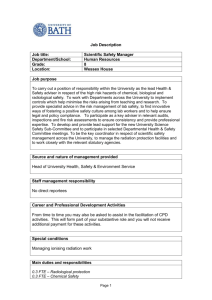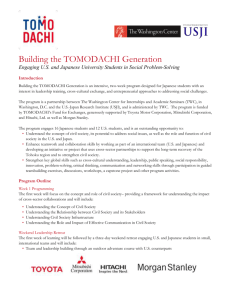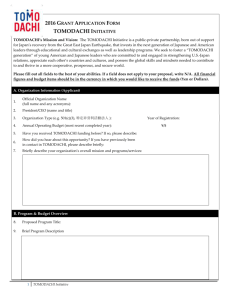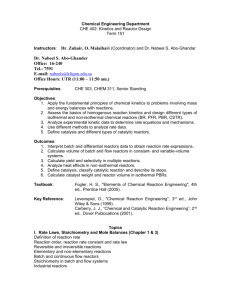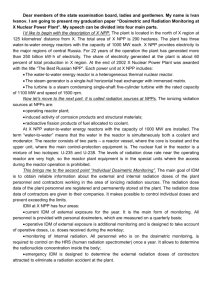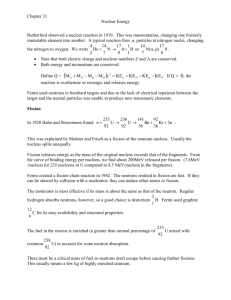Communications
advertisement
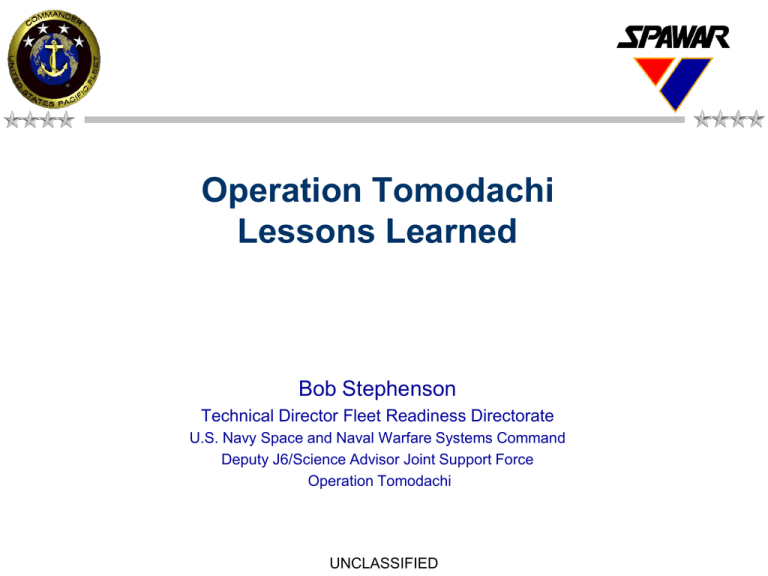
Operation Tomodachi Lessons Learned Bob Stephenson Technical Director Fleet Readiness Directorate U.S. Navy Space and Naval Warfare Systems Command Deputy J6/Science Advisor Joint Support Force Operation Tomodachi 1 UNCLASSIFIED Operation Tomodachi • U.S. Military support to Japan after Great Eastern Japan Earthquake •Combined effects of earthquake , tsunami, and radiological accident • 125,000 people homeless, 21,000 dead or missing • Tidal wave caused power outage at Funukoshi Daichi Nuclear Plant -3 reactors with partial meltdown of the core -3 reactors with spent fuel pools damaged - Reactor fission products (Iodine, Cesium, stronium, cobalt) released into the air and sea resulting in 30 KM “hot zone around the plant -Lethal radiation levels inside the reactor buildings Challenges • Assist to JSDF to •Locate survivors/remains • Assess damage •Assist in cleanup/restoral of ports and airports • Monitor reactors and measure radiation levels • Radiological consequence management Things that helped us succeed • Pre-existing Infrastructure to support large influx of personnel • Strong US-Japan alliance with robust CENTRIXS network • Communicators from all four services with a knowledge of each services unique capabilities and talent to make rapid changes in a hurry • Local DAA allowing rapid and flexible network changes 4 Things that helped us succeed • Development of an Information SOP early in the operation that facilitated information sharing • On call mobile communications assets we could modify to meet our requirements • Ability to locally develop an application for a common operational picture to permit informed decision making by senior leadership 5 UNCLASSIFIED Radiological COP • Needed to show laydown of US and JSDF forces • Needed to show location of air and water radiation plumes • Needed to show HA/DR info (roads, shelters, major damage • Need to show radiation sensors (US and JMSDF) Solution • Based on CENTRIXS Google earth server on GCCS-J at JSDF HQ Ichigaya • Wrote tools to data mine sensor and other source data. Applications written, tested and employed by an O-1, and E-3 and a contractor (Fleet Systems Engineer) • RADIANT Mercury repaired. New rule set to trasfer .KML files from unclas to to CENTRIXS J. Result Things to improve in the Future • Enterprise networks cannot support crisis – – – – • • No process exists for rapid changes to support Commanders urgent needs In a crisis, you don’t drive the timeline Complexity and size of the enterprise does not support rapid injection of new capabilities Enterprise does not support coalition data sharing Mission secret networks are a must, but they must have common tools with the Enterprise, and they must be able to communicate to and from the enterprise. A Common Operational Picture is critical, but it must be more than GCCS – Geospatial Information Services are a powerful data fusion tool • Crisis requires quick response – – – • • • Must be able to rapidly add seats to existing networks Must be able to bring in new capabilities to meet operational requirements Must be able to do this without having to contract (fee for service does not work in a crisis) Standard IM/KM practices are essential as a starting point. Current IA policy and practice supports neither network security, or rapid technology insertion Need data services to the tactical edge. – – Need web services that will work to low bandwidth, high latency, disconnected user (i.e. ships) Need to balance access to a wide range of users, with security QUESTIONS? 10

